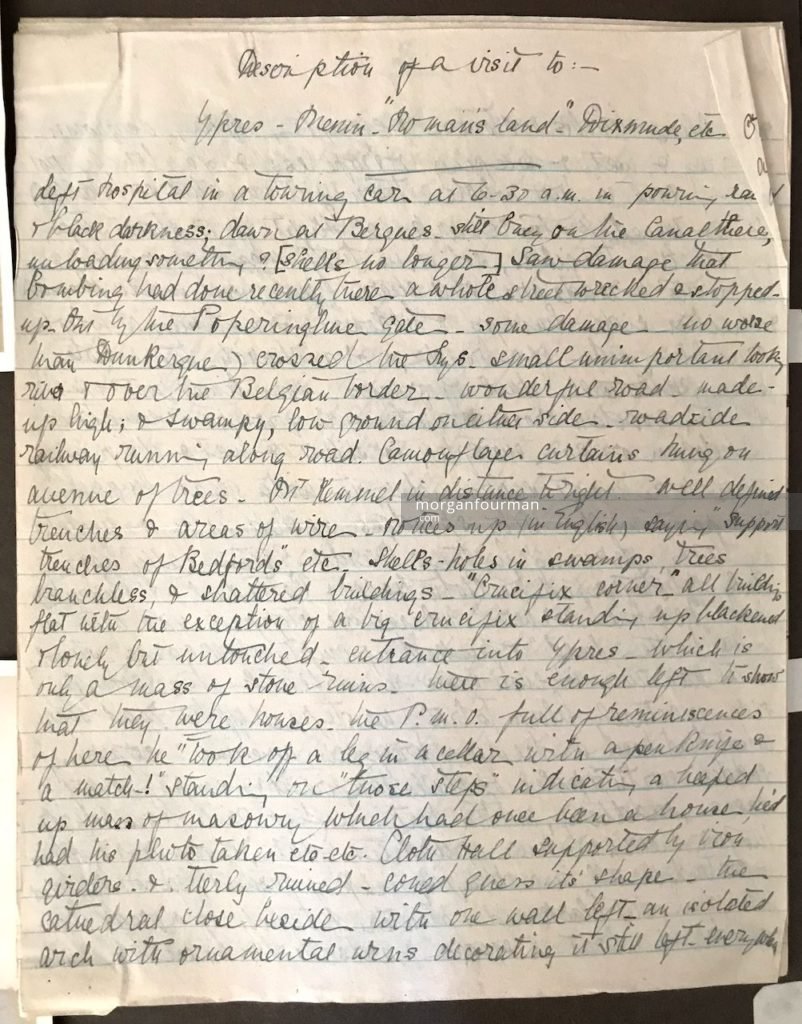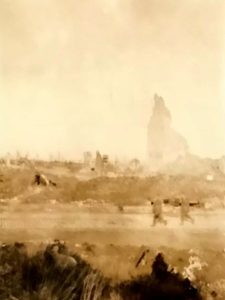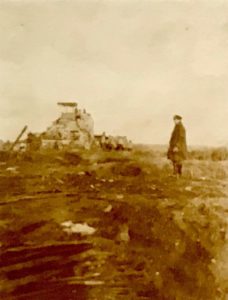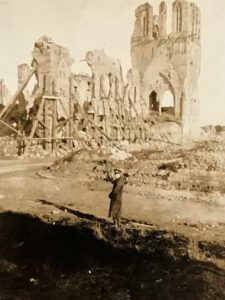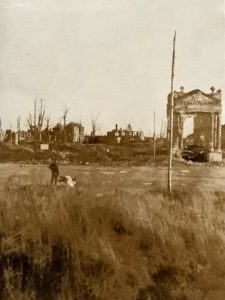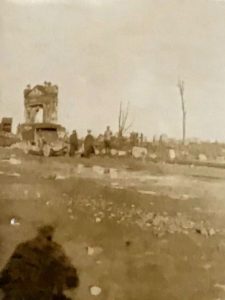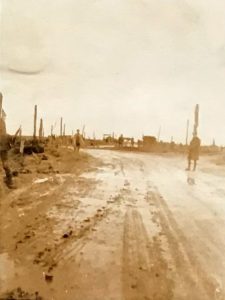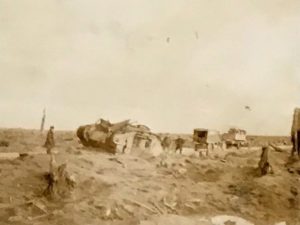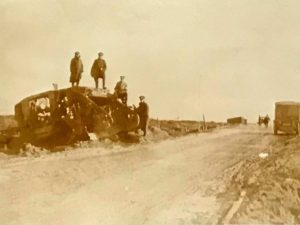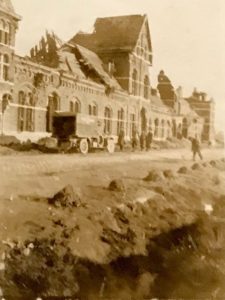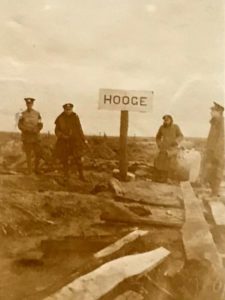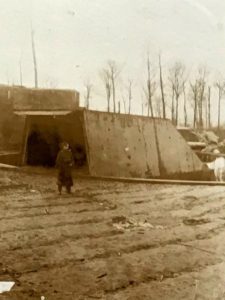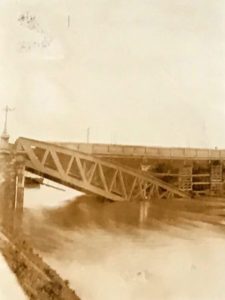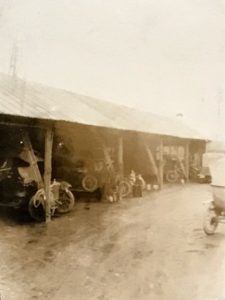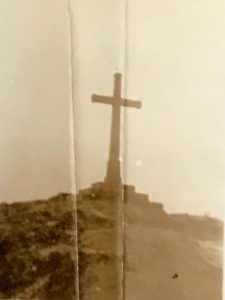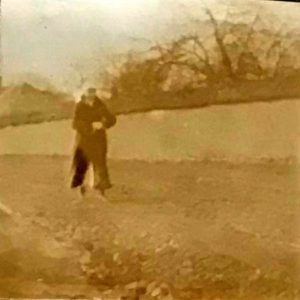The following is a description by Molly Evans, then a 28 year old nurse, of her day trip into “no man’s land”, immediately after the armistice on December 11, 1918. She was based with The Friends’ Ambulance Unit, the Queen Alexandra Hospital, Dunkirk at the time.
The handwritten pages are in her scrapbook, from where the images on this page are also drawn.
From Molly’s diary we know at least 2 people who accompanied her on the trip – PMO and Mr Cadbury (we presume Dr Humphrey Nockolds and Mr Laurence Cadbury). And her note written on the “Carte routière pour automobilistes et cyclistes” tells us the exact route – “motored from Dunkerque to Poperinghe, Ypres, Menin, Courtrai, Roulers,Thourout, Dixmude, Perwyce, Furnes”.
Here is a transcript followed by pictures taken on the day.
Description of a visit to:-
Ypres – Menin – “No Man’s Land”- Dixmude – etc.
We left hospital in a touring car at 6.30am in pouring rain and black darkness – dawn at Bergues – still busy on the canal there unloading something? [shells no longer] Saw damage that bombing had done recently there – a whole street wrecked – & stopped up out by the Poperinghe Gate – some damage no worse than Dunkerque – crossed the Lys small unimportant looking river and over the Belgian border – wonderful road – made up high & swampy low ground on either side – roadside railway running along the road – camouflage curtains hung on avenue of trees – Mt Kemmel in distance to right – well defined trenches and areas of wire. Notices up in English saying “Support Trenches of Bedfords” etc. Shell holes in swamps, trees branchless and shattered buildings. “Crucifix corner” – all buildings flat with the exception of a big crucifix standing up, blackened and lonely but untouched.
Entrance into Ypres which is only a mass of stone ruins – there is enough left to show they were houses. The PMO full of reminiscences of here. He “took off a leg in a cellar with a pen knife and a match!” standing on “those steps”, indicating a heaped up mass of masonry, which had once been a house, he’d had his photo taken etc etc. Cloth Hall supported by iron girders & utterly ruined – could guess its shape – the cathedral close beside with one wall left an isolated arch with ornamental urns decorating it still left – everywhere crumbling bricks and stones and everywhere getting overgrown, all grey & wet & weeping & hopeless & so lonely, not being a living soul in the whole town (if it can still so be called). It is so ruined that one remarks a flight of 3 stone steps as something tangible, solid, in that mass of wreckage. The streets and roads are still clear – have been made passable & on either side humps and hollows & sometimes a whole crumbling side of a building or a church – the whole place pathetically full of graves – sometimes just one solitary wooden cross, sometimes in groups or cemeteries of a dozen or 20 – everything is silent & wet & dripping. There is a moat surrounding it with great huge rampart walls with splodges of shell holes and marks in them. Leaving by the Menin gate (after having duly photographed the Cloth Hall and the Cathedral of St Pierre etc) past “Hell-fire Corner” where we stopped got out on to the “battle field” and picked up empty shell cases – standing in it the ruin is even more remarkable – the country side is actually blown to bits. We stepped off the road over what had been a hedge perhaps an avenue? sopping sodden earth and piles of shells (unfired), empty shell cases, saddlery, a tin hat – a few Mills bombs (with the pin still in!), tins of cordite & filling of some sort, clips of cartridges all in a decaying heap of ground, the only solid thing being the blackened splintered trunk of a great tree – all this in about 2 square yards and I suppose the whole of Ypres covered about 2 miles square? there was one chimney stack left most remarkable looking, the only height anywhere as far as we could see – [the enemy had not destroyed this as it served as a guide for shelling various quarters of the town]also the arch over the gate we left by was intact – I suppose because it was between two great rampart walls – looking back to Ypres from where we stood it looked as tho’ some earthquake had shaken everything down and made it lumpily level, any space being taken up with piles of debris, the rounded shelter tops of corrugated iron, of dug outs, some tossed about and torn to pieces, others still miraculously in place & little ghosts of white groups (ie cemeteries) noticeable because the whole of the scene was a study in earth colour and muddy grey, a sight that deeply engraved in the memory and of which no picture could ever give any idea, the sad murkiness, the loneliness and the hopelessness of the few standing shattered shells of buildings, even still grey & graceful & beautiful against the grey streaming sky.
We were then in “no man’s land” which really defies description – the utter desolation and waste & perhaps the most striking thing is the distance, the area as far as one could see to the horizon on all sides – one complete desolation. Here no remains or suggestions of lines or trenches – simply a swampy mass – craters of shell holes (several together or hunes) everything marshy & water-filled holes & heaped up banks & only splintered stumps of trees (just to the left Sanctuary Wood – the remains of a number of great trunks left standing, black and gaunt with no branches – otherwise evrything flat, undulatingly flat – a sea of mud and shell holes the whole a dull coloured waste, dumps of ammunition just as it was left (the shells still in their basket-cases) gun carriages and tanks. I counted 17 at once at one time – all the same colour still camouflaged some standing on their “noses” the iron casing riddled through and through – everything else blown and shot away – some half sunk in holes of water – others run helplessly into a mud bank, some on their sides and some even with barely a skeleton to mark what it had been – these great colossal iron things seemingly the embodiment of strength just strewn about and battered to pieces as though they were leaves blown about in a wind – in the drab coloured view they were scarcely remarkable but they seemed to emphasise the feeling of “failure” of everything all around. We passed a humped up pile of apparently mud and debris – not even a two foot-high wall left – that was the village of Hooge (it was marked with a white sign board) Gheluveldt was the same mile after mile of this dripping swamp waste – the only solid thing being the road – a marvel and triumph of ingenuity – even that every now and then made a neat detour (apparently) a circular pond, in reality the result of a mine – rolling down after down (or had it been heathland – impossible to guess) of complete and utter ruin and desolation.”Hill 60″ just to the right a misty dim more definite rise in the country side – otherwise nothing but the continuous dripping dead uselessness – occasionally the remains of a dug-out, an unburied horse, hauled up against a mound & always & everywhere the inevitable little crosses (as many German as English) mark the numberless graves – railway lines turned and twisted like wire & sticking up staringly into the sky – it sounds an exaggeration to say that there was nothing left but the road but literally there was nowhere to step – all shell holes, dumps, masses of tangled twisted barbed wire, rifles, equipment, a solitary block-house or two and always the endless swamp and water filled holes & unutterable mud – and no life (with the exception of crows) anywhere – a ghastly hopeless uniformness of colour, & lack of form or shape of anything anywhere – just a terrible nothing. This stretched for miles then trees with a branch or two left came into view, the remains of a hedge and actually in the distance an almost complete church spire – it restored one’s sense of reality – then gradually ruined forms of buildings became visible – there whole tracts of land that you could see clear and not covered with wreckage – here we were on the German side – a German side track train wrecked – German howitzers & abandoned field guns – neater more recognisable – dumps of ammunition & everywhere German notices & directions – then came Menin a ruined and deserted city – but not so completely as Ypres. There were some complete (shells of) houses & buildings out along a flat dull country road – being repaired by German prisoners under the Belgians – everywhere little farms with perhaps its barn smashed in or its rafters sticking up against the sky – but nevertheless occupied in some places even as near to the Desolation as this – a few enterprising folk were building houses on to their exposed cellars.
Courtrai next, quite whole & flourishing & industrious little town – typically Belgian with its square and characteristic Towers and Belfrois – one of which was utilized as a telephone wire supporter! the town had a few buildings destroyed a shell hole through this and a corner knocked off there but its streets were busy and its shops quite elaborate & of course all bridges were blown up by the retreating Germans – its modern as well as its priceless old picturesque ones. We came across a swinging wooden one thrown across by the R.E.s (English), who were still guarding it. We went to the hospital (for Belgian civilians nearly by us) some 200 cases all wounded by shells falling in their cottages or gassed or sick or now particularly “booby traps” or playing with unexploded shells or fuses – numberless children in.
Lunch in a hotel, quite civilized except that a shell had destroyed part of a corridor & we had to scramble over bricks & mortar & wood to get to the Restaurant part – the people had been there all the time with the Germans – had always had sufficient food tho’ at an enormous price – eggs being a franc each & a pound of butter 50 francs!
Set out again past Heule and Iseghem towards Roulers along a terribly muddy road but the Pave was in good condition the occasional traffic consisted of peasant families returning to their ruined homes – pushing those queer long curved wheel-barrow – or hand-carts drawn by dogs. Flat and very “Flemmish” country – with shell holes neat and round making pools in their fields and land – windmills some complete ruins others still standing. The Yser winding in and out of many canals – things seemed very destitute and deserted – but of course the indefatigable Frenchman and Frenchwoman were working in the fields – ploughs being drawn by Bullocks – & all the country carts were harnessed to cows – all the country folk seemed pleased to see us & called Engleesch after us – sometimes our welcome was embarrassingly effusive & we were treated as Royalties! We passed a few aerodromes – had been German now taken over by us & the Americans – all along the roads or rather the trees lining the roads were our telephone wires tracking from tree to tree – all posts were demolished by the shelling – sometimes one raw and poor derelict pole lying in a ditch its “head” chopped off in a tangle of innumerable wires – but all through everywhere the road was perfect apparently repaired at once when a shell had hit it. Roulers was the next big town although that was not such a ruin as Ypres it was impressive beyond words from its “desertedness” – it was sufficiently complete to still have the appearance of a town – & street after street – it is a big town – with square and mayoral buildings etc apparently intact – but they were husks or only skeletons of houses – all burnt out or roofs gone or fronts gone sometimes exposing the whole inside with its cheery wallpaper still almost untouched – remaining so that you could tell which had been the bedrooms & which the parlours – & once or twice I noticed some very pretty wall paintings or frescoes exposed to the pouring rain and relentless winds – it was different from the other ruined places because it was so “neat” – the empty houses were not full of bricks & mortar & timber & charred heaps of stuff – clear & empty & utterly still & deserted – a ghostly sort of town.
The abnormally big long-range gun at Hangenboom was our next destination (south of Ostende) interesting to us all at Dunkirk as it had so often damaged us and caused so much loss of life & property – it was lodged in a wood (we got down from the car to investigate thoroughly) in a great “emplacement” of cement – wonderful camouflage arrangement – it reminded me of a railway engine (with its funnel elongated and placed horizontally at its end) as much as anything – it was quite as big and perhaps idea was induced by its being on a turning-apparatus like engines are turned on – its muzzle was camouflaged – everything was left exactly as when it was last fired – the shell left in the cement dug-outs were so big that they had to have little trolleys to carry them up to the gun – there were still 4 waiting to be fired (a cleverly concealed & contrived railway track in the wood brought the shells up from a distance) lying there they looked about 1 yd 1/2 tall and 1/2 broad diameter – 17in shells they were – its impossible to grasp the idea of one of those ghastly objects flying through the air exploding some twenty miles distant. However I know too well & too often that I can!! All this dreary dripping day we seemed to have entirely to ourselves – so strange seeing no guards or sentries anywhere.
Our next objective was Dixmude – to get to the gun we had come off the main road & we nearly came to grief just as we started by disappearing car & all into an immense shell hole (it was just getting dark) in the middle of the lane we had selected to lead us back to the main road. There were shell holes all around the gun – very near – some pretty good shooting directed by our air men (I’d seen aerial photos of that gun while she was still in use on us) the engine part of the gun was encased in a great iron hood. Our then long run to Dixmude we al groups of blue-clad French soldiers driving picturesque hooded transport wagons & sometimes khaki groups once a batch of Russian prisoners & once a stream of khaki caterpillars drawing immense guns along – otherwise an uninhabited looking country – got lost and found ourselves at a cross roads with the sign post obliterated & in a ruined village with a stream and canal running through – occasional walls and frames of houses desolate and lighted only by a “murky moonlight” – we decided it must be Beerst & pushed on – if there had been anyone to ask it was impossible owing to the language – very few of the peasants “had” any French and Belgian is only get-at-able by speaking German, which they hate! More “no man’s land” too dark to see much – one was conscious of the general uniformity of everything, but there was more water that presently developed into floods – the flooded area, in fact, which for utter dreariness capped anything I’d yet seen – there was a camouflage screen along the road (which latter here consisted of logs of wood almost entirely, so marshy was it, & quantities of small bridges) & looking through this on the miles of desolate waste water in that grim half light was more ghostly than anything imaginable – the ruins of Dixmude – were about the same as Ypres – only it had that rushing Yser winding in & out & the ruins seemd to “crowd” on one more – less wide spaces than in Ypres, which seemed wider and clearer by comparison. The road was narrower – the heaps of debris came to the very edge- silent & gruesome – & everywhere rats and the sound of water – full of ghosts & one could think of nothing but the horrors of the Battle of the Yser, which had been though over that ground.
Pervyse, our next destination after another long run through “no mans land” – this was ruined just as the others – but it was quite dark and except for the what was lit up by our headlights one couldn’t see much – at a cross-roads we found a family evidently returning home, with all its furniture in a little cart, of whom we asked the way. An unintelligible conversation led to the result and final discovery that we were both asking each other the way to Furnes!! we arrived safely a charming old fashioned town with a delightfully picturesque square – more or less “whole” only a house here and there demolished – somehow giving the appearance of having thrown itself into the street and crumbled to mortar dust in doing so. Then along the familiar Furnes road & canal into Dunkirk and up the hospital arriving about 7 pm.
Impressions after a visit to:-
Ypres – Menin – “No Man’s Land” on 11.12.18
Nothing one can read, or hear, or see can make one ever realise the vastness, the appallingness of the “Waste”. Waste of everything, life, man’s effort, God’s earth. One feels that one has attended the most stupendous, awe inspiring and impressive – Worlds Nation’s memorial. It is like seeing some great play – the greatest that the world has ever seen or imagined – but with this difference – that the scene & the actors are – or were – Reality.
One cannot be grateful enough for the Privilege of being allowed to see the Desolation. It is such an immense “Greatness” that it surpasses anything that one has ever imagined – everything – even things that seemed of big personal importance of no significance beside it all. It is not that they really dwindle in importance but rather that the Grandness and nobleness of all that “no mans land” stands for, so overwhelmingly vast that one’s self and one’s concerns seem immeasurably small by contrast. One has never before been confronted by any Human Thing, thought or sensation to equal it & it leaves one with a feeling of humility before it.
To go over that ground (to me the most Holy Sacred spot in the World) could not fail to stir depths in the shallowest of mortals. I can’t quite say what was uppermost in my mind – I think it was the intense admiration and thankfulness to the men who’d won through anything so inhumanly awful – appalling sadness and undying – tho’ proud – sorrow caused by those innumerable graves. They all belonged to people about my own age & to whom life was just as sweet as it was to me & yet…
It seems great presumption on my part to express what in any case is inexpressable & what can never be done justice to, even by the greatest Poet, Artist or Musician the World can ever produce. I only know that with the greatest feeling of awe, I am convinced that I have just looked upon & experienced the most wonderful sight in the world & nothing that I shall ever see in any country at any time can ever approach the immensity of it or ever lessen the impression its made on me.
21.12.18
You’re wrong M.E. – some people have just come back from the same places you went through & the one thing that they tell of which seemed to impress them most is the fact that they danced the Lancers in the Inn garden at Courtrai!
